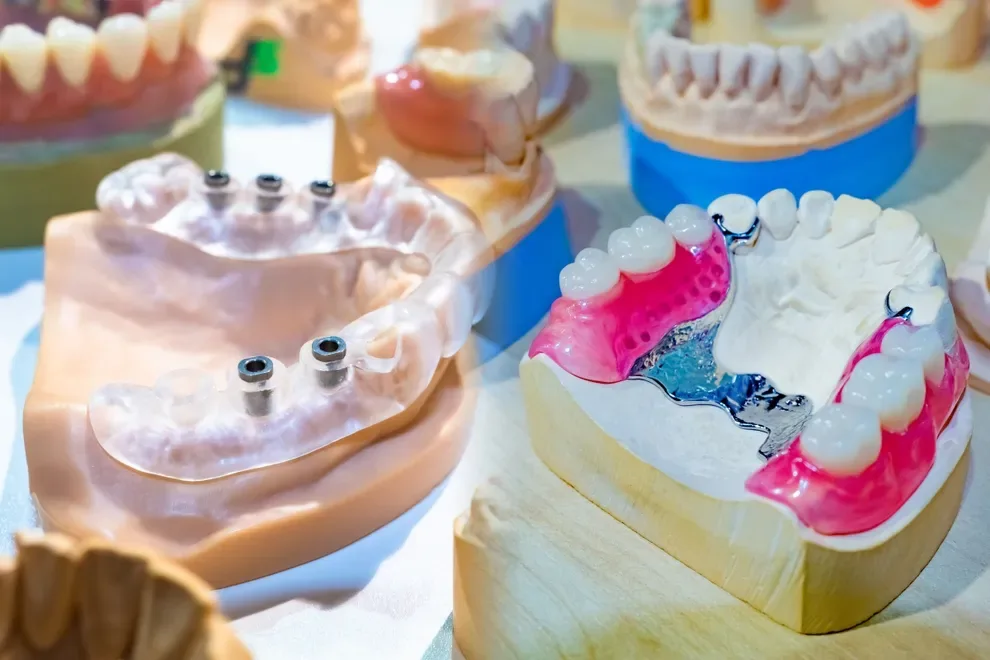Dentures vs. Implants vs. Bridges: Comparison of Costs & Benefits.

Table of Contents
- Dentures
- Implants
- Bridges
- Further Methods
- References
Modern cosmetic dentistry can quickly improve your smile via many options that replace broken, misaligned, misshapen, or missing teeth. Several materials can fill in, cover, or replace your permanent teeth if they cause problems for your oral hygiene. If you are missing teeth, dentures, bridges, and implants are all viable options.
If you lose a tooth due to infection or injury, the surrounding teeth can shift over time, which may cause other oral health problems later. Dental implants, bridges, and dentures can fill in these literal gaps, so you not only look your best, but you keep your teeth, gums, and jaw healthy too.
We break down how these options compare below, so you can decide with your dentist whether implants, bridges, or dentures are best for your situation.
Dentures.
When you have several missing teeth, your dentist may recommend dentures. These devices are designed to restore both your appearance and oral function.
Dentures can help to keep you healthier overall. They help you chew, speak clearly, and feel confident in your appearance. Depending on how many teeth are missing, you can get either partial or full dentures.
A denture is made with a plastic base colored to match your natural gum tissue, with either plastic or porcelain teeth to replicate where your missing teeth were located. This device is worn throughout the day, but usually removed at night so the gums and jaw can rest.
Full dentures form a seal on your gums, either with a special adhesive or attached using a special dental implant. Partial dentures have either a plastic or metal framework at the base, with replacement teeth set up to match their opposing teeth.
Typically, full dentures are long-lasting cosmetic replacements. Partial dentures are intended as temporary solutions while you wait for gums and bone to heal before getting a different type of implant, like a bridge.
You may return to your dentist every few weeks or months after you first receive dentures, to have them refitted or adjusted to fit properly in your mouth. When cared for properly, dentures last up to five years.
Depending on the material used to make your dentures, they may cost up to $2,000. Dentures are not recommended by dentists unless they are medically necessary. This means your dental insurance is likely to cover some of the cost, often making dentures affordable for those who need them most.
Dentures, implants, and bridges all replace teeth that have been lost to injury or illness.
Implants.
Dental implants are currently the best way to replace natural, permanent teeth. The implant itself is a dental screw, which replaces the root pulp from the original tooth. A crown, which is designed to resemble the original tooth by fitting into its spot and supporting the surrounding teeth, is then placed on top of the implant.
Modern dental implants have existed for about 30 years, although the concept of replacing individual missing teeth with implants has existed for thousands of years.
Dental implants are the strongest devices available to support replacement teeth and help you maintain a beautiful smile and your oral health. Implant surgery is also one of the safest and most predictable procedures in dentistry.
The crown over the implant may need to be replaced every 5 to 15 years, depending on the material it is made from and how well you care for it.
Unlike dentures and bridges, implants can prevent bone loss. In fact, implants often stimulate bone growth in your jaw, which keeps your mouth healthier overall.
There are some risks with dental implants, including nerve damage at the surgical area, an open incision following the surgery, exposure or infection at the implant site, or movement of the implant so the tooth appears crooked. Talk to your dentist about the likelihood of these risks in your specific situation.
The total cost of an implant procedure depends on the number and type of implants, what the crowns are made from, and if any other procedures are necessary to prepare your gums or jawbone for the operation. Implants are customized to fit your mouth, and this affects the price as well.
While some people choose dental implants for cosmetic reasons, most people get this device because they need a tooth replaced. If you need the implant after losing a tooth to illness or injury, your dental insurance is likely to cover part of the cost. In some cases, dental insurance will cover the cost of the implant but not the cost of the crown.
The upfront cost can range between $3,000 and $4,500. Confirm the amount your insurance will cover beforehand, so you won’t have any financial surprises later.
Bridges.
A dental bridge replaces one or more missing teeth with replica teeth, using one or more natural teeth on either side to hold the bridge in place. Bridges can be either permanent or removable. The removable version of a bridge is also sometimes called a fixed partial denture.
A bridge has an underlying structure that provides support for one or more replacement teeth. The support structure is then anchored onto crowns that cover natural, permanent teeth on either side of the gap. The bridge allows you to chew and speak normally, and can restore the appearance of your smile after you lose one or more teeth.
There are four basic types of dental bridges.
Traditional bridge: This type of bridge uses two crowns on either side, called abutments, to anchor the bridge.
Cantilever bridge: This bridge uses only one crown for support.
Maryland bridge: This type of bridge anchors via porcelain or metal frameworks attached to the back of the teeth, making it less invasive.
Implant-supported bridge: This type uses dental implants rather than natural teeth as anchors.
As with an implant, getting a bridge is a form of oral surgery. Your mouth may be sore for a few days after the procedure, but this typically goes away as your gums and bone heal.
There are some potential complications that could occur, including bridge failure, pain or chewing issues, tooth decay, and infection. These are rare.
A bridge implant typically restores function to an area. If you follow your dentist’s post-surgery instructions, bridges can help you achieve a beautiful, healthy smile.
The total cost of a dental bridge depends on several factors, such as whether you need one tooth replaced or more, what the bridge is made from, and how the bridge is anchored in your mouth.
A simple Maryland Bridge can start at $250 for a wing, with an additional $600 for a false tooth. Two wings and two false teeth can cost up to $3,500.
Traditional and cantilever bridges usually start around $500 but can go all the way up to $12,000. They last anywhere from 5 to 15 years.
Any crowns or implants you need to support the bridge will be an additional cost, as they are considered separate dental devices. Your dental insurance may cover about half the cost of the procedure and bridge.
Further methods to support your oral health.
When you struggle with illness or injury that leads to tooth decay and loss, you need help from a dentist to replace these teeth with the best possible option. Implants, bridges, and dentures are all ways you can replace missing teeth, maintain good oral health, and restore your smile.
Depending on what type of procedure you need, your dentist may also recommend adjusting the alignment of your teeth.
Good teeth alignment can reduce your risk of tooth decay and infection since the surfaces will be easier to reach and clean. This means better overall oral health.
After you get dentures, implants, or bridges, it is usually more difficult to adjust crooked, crowded, or gapped teeth. As a result, teeth alignment may be part of the overall strategy before these devices are put in your mouth.
If alignment is part of the plan, you have several options to straighten your teeth, ranging from traditional braces to doctor-monitored, at-home teeth aligners. If you are a candidate for at-home aligners, they usually present the most inexpensive and fastest route to straighten your teeth.
